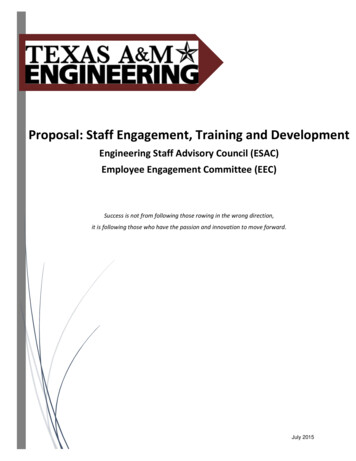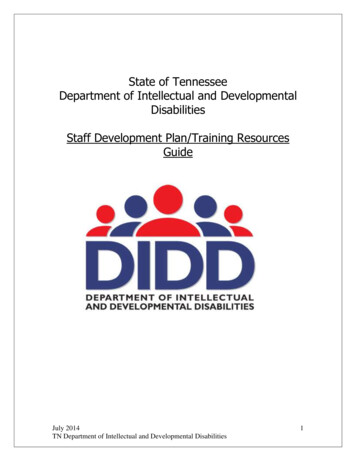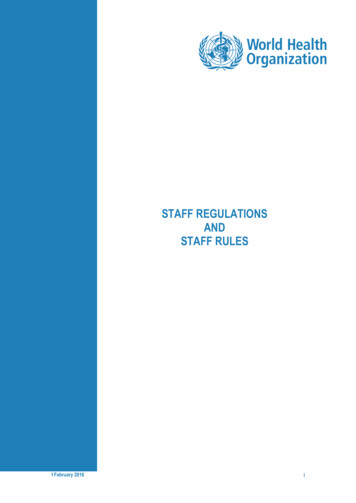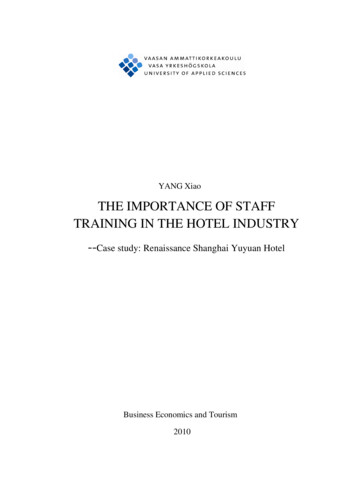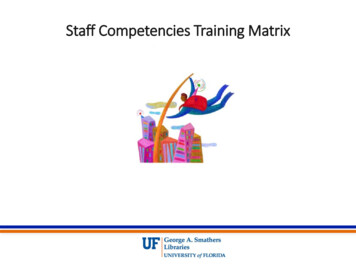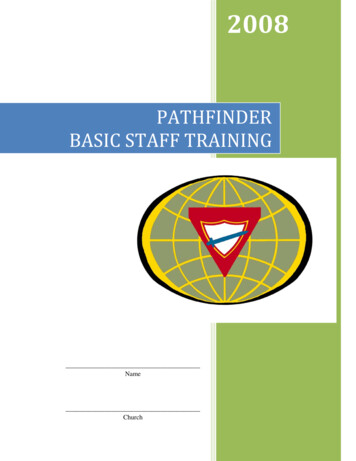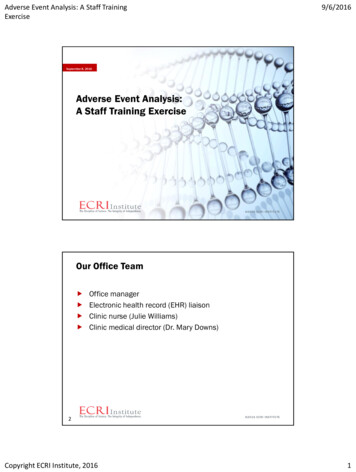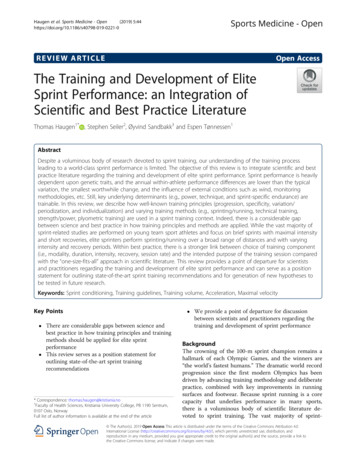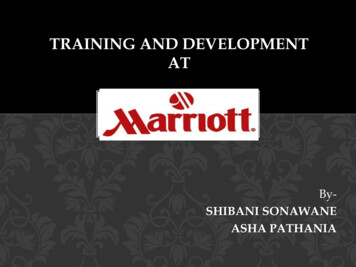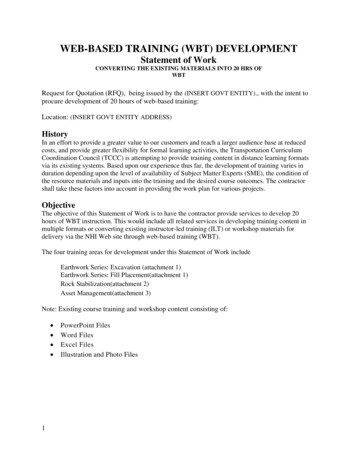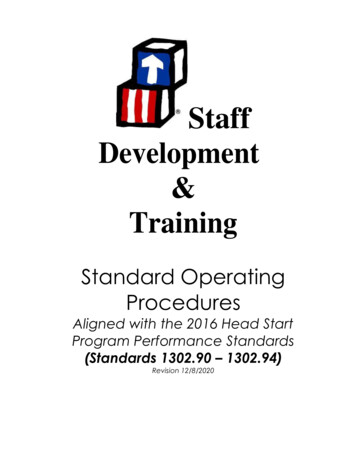
Transcription
StaffDevelopment&TrainingStandard OperatingProceduresAligned with the 2016 Head StartProgram Performance Standards(Standards 1302.90 – 1302.94)Revision 12/8/2020
1 Page
Table of ContentsNEW HIRE ORIENTATION OVERVIEW . 3Professional Development and Staff Training Process: . 5Staff Development and Training Handbook . 6Section I.A. How to Request Training . 6Section I.B. New Hire Orientation . 62.Instructors responsibilities . 73.Participant responsibilities: . 84.Training Reports . 8Section I.F. Training for CEUs . 9Section I.G. Modular/Programmed Learning . 9Section I.H. Training Requirements .10Section II.A. Training, Conferences, Seminars, etc.14College/Certification Training .15Section II.B. CDA Training Policy .15Section II.C. Improving Head Start School Readiness Act of 2007: TeacherDegree Requirements .18Section III.A. Reports to Campuses .20Section IV.A. Reports to Individuals .21Section IV.B. Graphics, Handouts, videos, etc.21Section IV.C. Audio Visual Equipment .22Section IV.D. Training Facilities .23Section IV.E. Ethics .23Section V.A. Professional Development Plans .24Section VI.A. Required Training (Nutrition) .24Section VI.B. Required Training (Bus Drivers) .26Section VI.C. Required Training (Bus Monitor Training) .27Section VI.D. Required Training (Safety Evacuation Training) .27Section VI.E. Required Training (Transportation/Defensive Driving).28Section VI.F. Required Training (15 clock hours for Teachers) .28Section VI.G. Required Training (CLASS Reliable Certification) .292 Page
NEW HIRE ORIENTATION OVERVIEWCSNT Head Start/Early Head Start provides orientation to all new staff andvolunteers. Orientation for staff consists of an introduction to the HeadStart/Early Head Start goals and the underlying philosophy of the program.New staff are also given copies of the Head Start Program PerformanceStandards and are introduced to each component of the programincluding the Management Team. The Human Resource Director willfamiliarize new staff to the CSNT Personnel Policies and Procedures, and theProgram Manager will educate them on the proper methods for identifyingand reporting child abuse. Transportation/Bus Monitor training is alsoavailable to all new staff/volunteers during orientation. This orientation isprovided to all new staff. Staff rehired within six months are not required tocomplete new Hire Orientation.The orientation for volunteers is provided in the campus by the CampusDirector. They are given a Campus Operating Manual that details all of theinformation about the volunteer program at CSNT Head Start/Early Head Start.All information on volunteers is monitored and tracked at the campus level.Orientation for parents is provided during parent orientation in the Campusby the Family Service Worker. Documents are discussed and signed with theparents. Parents also receive a copy of the Campus Operating Manual thatoutlines the parent’s civil rights and procedures on how to report when theyfeel there has been a violation.New Hire Orientation for CACFP StaffStaff that are hired to work with the CACFP are given an orientation to theprogram. Staff participates in the program new hire orientation that includesinformation on policies and procedures, regulations that govern the program,child abuse reporting, bus monitoring, and the Head Start/Early Head Startphilosophy.Once the employee completes this process, they meet with the NutritionManager to discuss the CACFP basic food service and how to complete theforms associated with this process. The employee normally spends three dayscompleting this process at the administrative office.Once this process is completed, the employee will spend five days in the fieldworking side-by-side with a CACFP certified cook. During this time theemployee will complete all of the training listed on the Food ServiceEmployee Basic Training on Policies and Procedures. Once the five-daytraining is completed by the employee, the training cook, the CampusDirector, and the Nutrition Manager sign the form. A copy is kept in the3 Page
employee personnel file in the administrative office and at the Campusoffice. The Nutrition Manager also keeps a copy for their records.(All new staff that performs key administrative activities for the Child andAdult Care Food Program go through the same training that is listed above,along with administrative type trainings through the Texas Department ofAgriculture.)Goals for the professional development and training component:Goal:To improve student performance at each Head Start andEarly Head Start Campus in the CSNT service area byproviding quality staff development and parent training.Objective:To provide quality-training opportunities to staff, parents,Policy Council and Governing Board members that meetsa diverse range of levels, interests, experiences, andcircumstances.Expectations: To provide state of the art training for staff and parents; To manage and assist career development with ideas forgrowth and development for upward mobility; To provide up-to-date training materials and accurateinformation to Head Start staff and parents; To promote parent involvement and valuable parentteacher team building.4 Page
Professional Development and Staff Training Process:The following approach is taken when planning and delivering a qualitycomprehensive training program:1.) The Head Start Director and administrative staff share theresponsibility for the staff development process. This isaccomplished by collaborating with and providing necessaryinformation to Training.2.) Review of the Head Start Program Performance Standards and theService Delivery Plan to ensure that the activities in each area areintegrated into the Staff Development Plan. For example, theHealth and Safety area would include training activities to ensurethat all staff responsible for health screenings are trained in a timelymanner to allow them to meet the 45-day time frame.3.) Review job descriptions to ensure compatibility with training goals.Each staff member develops individual goals to be reviewed duringthe Annual Performance Evaluation. Professional DevelopmentPlans will be developed as a part of the Performance EvaluationSystem.4.) Assess individual and program training needs using information fromstaff performance appraisals, individual surveys, CommunityAssessment, Self-Assessment, Head Start Program PerformanceStandards, and the Service Delivery Plan.5.) Determine resources available (time, money, staff, etc.).6.) Develop a training calendar.7.) Present training budget to Policy Council and Governing Board.8.) Implement the training plan.9.) Document training efforts, attendance, and results.10.) Evaluate and provide appropriate follow-up.5 Page
Staff Development and Training HandbookSection I.A. How to Request TrainingAny staff member of the Head Start and Early Head StartPrograms can request training sessions.This can be done by:a. Completing a Training Request Form. Anyone wanting torequest a training session or series of training sessions shouldcomplete this form and forward it to the Program Manager.The Training Request Form is available from the CommunityServices Website or from the Campus Director.b. Training is also requested through staff surveys on at least anannual basis.c. DO NOT submit verbal request for training that you would liketo attend. ALL REQUESTS FOR TRAINING MUST BE SUBMITTEDON A TRAINING REQUEST FORM.Section I.B. New Hire Orientation1. All new employees are required to participate and complete New HireOrientation before they begin their jobs. If New Hire Orientation is notoffered before that date, the employee will be scheduled for the nextavailable session and will be allowed to begin their job. (This is allowedonly when program services are interrupted due to an opening in thatposition.)2. New Hire Orientation covers a variety of training that consists oftraining provided at the Linden Administrative Office and on-the-jobtraining provided at the new employee’s campus.a. Agency Operation: This aspect of training includes a descriptionof the agency and the programs that are under the agencyumbrella, a list of agency personnel and phone numbers withextensions, and personnel policies, such as dress code,organizational chart, use of time sheets, paydays, job description,disciplinary procedures, etc.b. Program Implementation: This aspect of training includes childabuse reporting regulations, Head Start Standards of Conduct,discussion of Head Start Program Performance Standards,discussion of Texas Child Care Licensing Minimum Standards,Child and Adult Care Food Program Training, the proper way tolift blood borne pathogens, program policies and procedures,etc.c. Campus Orientation: This aspect of training includes informationon the daily operation of the campus including application of jobspecific procedures and job description performance details, theuse of time sheets, campus schedules, fire and weather drills, tour6 Page
of campus, minimum standards, etc.3. The Head Start Director is responsible for overseeing that New HireOrientation is conducted on a regular basis. Assigned agencypersonnel will conduct the New Hire Orientation.4. State and federal guidelines require that all staff have Orientationrecords available for auditing at the Administrative Office PersonnelFiles and at the Campus Staff Files.Section I.C. Training Records and Information1.Training records and responsibilitiesa. The Program will keep a database on all in-agency trainingactivities that are sponsored by the Program. The information onthe database is supplied through Sign-In Sheets. In cases wherea staff member receives training through organizations outsideof Community Services, the staff person is responsible forsupplying a copy of the training certificate for their personnel filein the Administrative Office and at their Campus.b. All individual staff members are responsible for keeping updatedTraining Log Sheet(s) of their training at their workplace, in casethere are data entry errors or Sign-In Sheets are not submitted.2. Instructors responsibilitiesa. Instructors should notify the Program Manager of any trainingactivities prior to the scheduling of the activity. This will allowtime to answer questions that anyone might have concerningtraining activities, prevent scheduling conflicts with groups orrooms, allow the Program to support the activity, and to monitorthe subject matter of the training.b. Provide the following information and documents within fiveworking days after the training activity:1. Completed Sign-In Sheet2. Printed name of participants3. Job title of participants4. Staff ID# of participants5. Job location of participants6. Name of training activity7. Date of training activity8. Time of training activity9. Length of training activity (in hours)10. Name(s) of instructor(s)11. Outline or summarize the training content7 Page
*If training is to be eligible for CEU certification, the following must be onfile: Statement of Specifics Form related to the topic, length and contentof the training; a Vita or Resume of the instructor(s), and completedevaluation sheets from participants.3. Participant responsibilities:a. Participants are to print names clearly on the Sign-In Sheet,include job title, job location and Staff ID#.b. Participants must not sign more than one Sign-In Sheet pertraining session.c. It is considered fraudulent and will require disciplinary action if: A participant signs someone else’s name on a Sign-In Sheet. A participant signs a Sign-In Sheet and does not attend thetraining session.4. Training Reportsa. The Program Manager will email each Campus a reminder toprint Child Plus Training Reports each September/October,January/December, and May/June.b. This report will contain: Training activities per staff member, length of each trainingsession, dates of training sessions, category of each trainingsession, job title of staff, and Staff ID number.*Copies of this report can be requested at any time byCampus Director. Because of the length of these reports, donot ask that it be FAXED to the Campus.c. Training reports of individual staff members can be issued uponrequest if the from employee, if the Supervisor is unable to printthe report (allow at least five working days).d. Unless otherwise requested, these reports will include: name ofstaff, name of training sessions, dates of training, length ofsessions, and categories of training.Section I.D. Training Conferences1. The Program sponsors trainings conferences throughout the year.Some of these include the Pre-Service Training Conference (usually inearly August), Summer Training Conference (usually in June/July),and the8 Page
Policy Council and Governing Board Training (throughout the year).2. The Program may also sponsor Training Days during each schoolyear. These are days that may correspond to the local ISD Staffworkdays. These are days where children are not in attendance.3. Unless otherwise informed, all staff are to attend and participate in allPre/In-Service Training and any Agency Training Conferences.4. Identified staff to attend Training Day activities will be notified by theirsupervisor.5. Participants at training conferences are required to use sign-in andout sheets at the beginning and end of each day. Training Sessionparticipation should be verified on the participant’s time sheet.Section I.F. Training for CEUs1. Staff needing CEUs should notify the Program Manager in writing oftheir need for CEUs so that training activities can be planned to helpmeet these training needs. Be specific about the number of CEUsneeded, special sessions required, and time limitations to acquire theCEUs.2. The Program has a partnership with Region VIII ESC Service Center toprovide trainings to staff. CEUs are provided to staff that attend thesetrainings. (See Region VIII ESC Partnership for information on how toregister for these trainings.)3. In order for any In-Service training sessions to qualify for CEUs, there area number of criteria that must be met. These criteria are primarily theresponsibility of the training instructor. Training has developed anumber of forms to meet these criteria.a.b.c.d.e.A resume or vita must be on file in Training for the instructor.An outline of the training session must be submitted.A Sign-In Sheet must be submitted.Evaluation Sheets must be submitted.A Statement of Specific Form must be submitted that contains theobjectives of the training and the purpose and benefits of thetraining.Section I.G. Modular/Programmed Learning1. Some of the training provided by Community Services is conductedthrough the medium of self-paced, modular or programmed learningtechniques. (These terms are used interchangeably in our agency.)The purpose of this form of training is to present a small amount ofinformation that the participant will study9 Page
and “test out” for competency. At the end of every modular learningexercise is a page for signatures. The participant’s signature on thispage verifies that the participant is knowledgeable of the informationin the module and is responsible for implementing that knowledge inthe function of his or her job.2. The verification or signature page of every training module is requiredto be submitted to Training within five working days of the date ofcompletion of the module.2. Although it is not true for all of our modular training, most of this trainingis for the purpose of reinforcing previous training or enhancing priortraining. Modular training has as its goal to provide documentation oftraining that is required of staff in a way that is less redundant andintrusive of staff time than traditional classroom type training. Thistraining is primarily in subject areas that are required on an annual orfrequent basis.Section I.H. Training RequirementsA.In-Agency Requirements1. Campus Directors are required to keep training records of all staff theysupervise. Administrative staff have the advantage of delegating thistask to Administrative Coordinators or the Human Resources Director,since this area is close enough at hand to be convenient.a. In-agency training functions will be forwarded to CampusDirectors at least three times a year, but out-of-agency trainingwill not be included on this quarterly report.b. It is suggested that staff who attend out-of-agency trainings keeptrack of these trainings on their training logs and provide trainingcertificates to supervisors and on a regular basis.2. Teachers are required to post in a prominent place in their classroom:a. College diplomas in Child Development, Early ChildhoodEducation, or related fields. All posted diplomas must be a cleancopy. (Other non-related diplomas are not to be posted in oraround the classroom.), orb. Current CDA certificates or a clean copy of CDA certificates.(Expired CDA certificates must not be posted.), andc. Current First Aid/CPR certification card or a clean copy of FirstAid/CPR certification card. (Expired First Aid/CPR certificationcards must not be posted.)10 P a ge
d. These certifications or diplomas are required by Head Startstandards and/or Texas State licensing requirements. They mustbe posted in a very visible place near the entrance to eachclassroom or next to the door outside the classroom.e. Teachers may also post other training certificates received, butthe posting of other certificates must not block or detract fromthe other required posted documents. Other certifications orcertificates must be directly related to childcare training andcan only be posted during the school year(s) in which thecertificate is current. Any other certificates not required to beposted must have Campus Director’s approval.For training activities, such as, CEUs or other professionally related training,these may be approved through the employee’s supervisor, but is limited tono more than 32 hours per calendar year and not more than a total cost of 500.00. The 32 hours and 500.00 is the outside limit, not a guarantee. Theselimits would not include Head Start/Early Head Start or NAEYC relatedconferences.B. Head Start Program Performance Standards Training Requirements1. Teacher In-Servic
Staff Development & Training Standard Operating Procedures Aligned with the 2016 Head Start Program Performance Standards (Standards 1302.90 – 1302.94) Revision 12/8/2020
